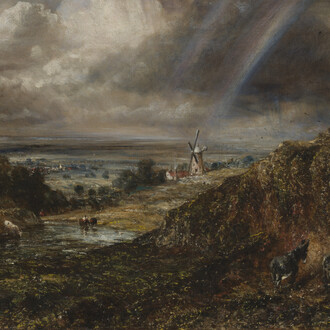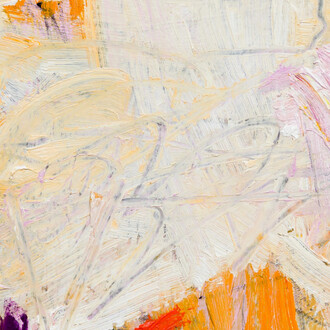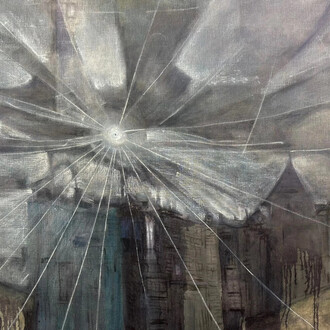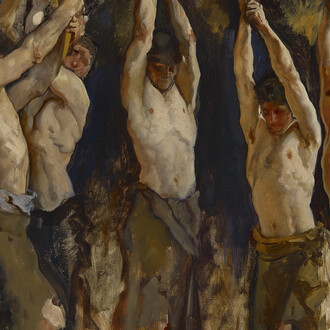On his return from war in 1945, Zangs immediately enrols in Düsseldorf’s Academy of Art, a school with a high reputation and the first of its kind in Germany to reopen its gates. There he studies until 1949, enriching the experience with travels across Germany, Switzerland and Italy.
In 1951, on an invitation from Dina Vierny, he gets authorised to travel to Paris. This initiatory trip marks his introduction to the international avant-garde, characterised by the modernist leanings of the Ecole de Paris, Art Brut, concrete and contemporary geometric art, lyrical abstraction, or even abstract impressionism and action painting from the United States. Whilst still pursuing a figurative painting style that had met with some approval across the Rhine, Zangs moves towards a new informal abstract expression.
In response to the capital’s new artistic spirit, Zangs uses paint dynamically and rhythmically, yet treats colour as a material that requires structuring. However, his artistic language is not based on the psychological transcription or cryptogram of an ego in the creative process, such as are found in surrealism’s automatic writing tradition. Georges Mathieu, or Wols and Hans Hartung, soon to play the major intermediary role between French avant-garde art and Germany’s evolution of Informal art, explore the dissolution of the traditional form, the subconscious and chance through gestural art and the very act of creation. For Zangs, on the other hand, artistic intention is characterised by the material structure and the expressive gestural strokes that animate the composition and thereby reveal the object to the viewer.
In 1952, the artist begins to paint figurative and material compositions, salvage objects, collages and assemblages of materials in white (see Catalogue Raisonné of Abstract Works of Herbert Zangs, Edition Emmy de Martelaere, Paris 2004, 2007, 2009, 2013). This act of “whitening” becomes more prevalent in the fifties concurrently with a reduction of the paint palette to an all but monochrome white.
Without evoking the significance of white in the history of religion, nor Kandinsky or Malevitch’s transcendental concept of colour, let us remember Lucio Fontana’s universal demands. In his 1946 “White Manifesto” Fontana states the need for “a change in the very essence and in the form” and proclaims the transition of art within movement, space and time that encompass all dimensions of existence. Fontana’s transgression of the surface of the image is echoed by Zangs’s pictorial integration of the object through “whitening”.
Herbert Zangs’s artistic language is mainly displayed using an experimental approach to all types of materials and their usage in the creative process. His painting is characterised by the contrast and the coherence of the material form, the rhythmical structure and a dynamic continuum. Where one gives unity to a work, the other signifies its openness within an environment through which only visual perception, the gaze of the observer, structures the image and its context above and beyond itself.
Moreover, Zangs recalls an experience with nature that lies at the heart of the “whitenings”, when he was a soldier on a mission in Scandinavia. One winter’s night, the landscape was covered with snow. What had been familiar was suddenly transformed and had become strange. Reality had lost its cohesion and required re-adjustment. Just as, after the war and throughout the world, the human condition called for reality to be appropriated once again.
The young artist’s experience when faced with nature, or that of the individual faced with reality, finds in the context of the perception an equivalence with the approval of the artistic work by the viewer. The process of creation is handed over to the observer in the open form of the work which, freed from all predetermined meaning, is completed thanks to the perception of the image in the visual process. The significance of the work is only regained through this visual experience, being defined as it is from that point on by an interpretation based on the viewer’s own experience.
It is also with that secondary order of the experience of the image that forms, colours, letters of the alphabet, symbols, arithmetical signs, or even the context of origin of the objects used in the composition give rise to thematic positions.
The artistic position of Herbert Zangs in the fifties is highly radical and innovative, yet it benefits from sparse public recognition or visibility. It is important to remember that in post-war Germany society and art critics were discussing whether it should favour figurative or abstract painting within a context of a general moral renewal of art. This coincides with the disassociation from figurative painting favoured by the East German system and the development of abstraction by a certain number of West German movements, notably the Zen 49 group formed in Munich in 1950, the neo-expressionism of the Quadriga group established in Frankfurt in 1952, the Gruppe 53 connected to Düsseldorf’s Fine Arts Academy, and a little later the Zero movement. But it is only with 1959’s documenta 2 that German abstract and informal art gains international recognition.
As Emmy de Martelaere documents in the Catalogue Raisonné, Zangs’s artistic language in the fifties moves from series such as Objects, Collages, Prints, Knottings, Foldings and Jutes, developing into Collages-Objects, the seminal Relief-Paintings series and the series of Paintings and Charcoals. We can see a transition from use of the object to painting; Zangs’s works show a more picturesque approach and perhaps a closer identification with international leanings at the end of the fifties.
Zangs exhibits regularly in London from 1957 to 1960, first at the New Vision Centre Gallery then at the Drian Gallery. He is the first post-war German artist to have a solo exhibition in England. The works created in London are first and foremost of a highly composed appearance. Drawings in charcoal and solid colours intercross the support surface used. Loose or controlled lines act on constructed forms, precise and spread out, transparent and opaque, concave and convex, open and held in, surrounded and crossed. The composition is dynamic and dominated by the interaction of contrasts seeking balance and harmony in the space. In the Kandinsky and Klee tradition, and by the mediation of the English critic John Anthony Thwaites in Munich, informal artists such as Fred Theiler or Rolf Cavael of the Zen 49 group, Herbert Zangs explores the movement of colour and form within a spatial structure in keeping with the preoccupations and work of the artists of the time. Indeed, it is probable that through the visualisation and definition of an imagined space, it would not be long before Zangs’s artistic creation would also express the cosmic ideology of the group and their search for balance, for a spiritual core akin to Eastern thinking, with the pursuit of neutralisation and restraint in the painting action.
The calm and picturesque quality of Zangs’s works from the first years of the English period are soon in contrast to an agitated structure worked with a windscreen wiper, superposing forms and lines onto a plane composition. Distinct expression of the creative process, rhythm and form are once again alienated, and in their equivalence the visual cohesion is constructed to ensure the viewer’s free perception.
Here too, just as in the act of “whitening”, a real life experience would appear to have prompted the creative process: a car journey in the rain with a field of vision disturbed by defective windscreen wipers, creating the division of real space on different levels, thereby offering an artistic vision which once again uses the classic codes of pictorial composition.
From the moment that the artist develops the windscreen wiper technique, charcoal drawings and the image’s picturesque structure are no more. The paint he uses varies from very liquid as in his windscreen wiper series of pictures to very thick and coagulated as in the Relief-Paintings series he produces at the end of the decade. The choice of colours temporarily darkens, as in the black series of Relief-Paintings. In the sixties, Zangs attaches particular importance to the materiality of texture and the rhythmical structure applied to the support. The application of regular and systematic traces becomes an action immanent to the image, an action styled as a creative manifesto.
With the monochrome white works and the series of Relief-Paintings titled “Vibrations”, Zangs became closer to the Zero movement which, not without ideological concept, proclaimed an artistic renewal based on themes of light and movement, consequently seeking to banish darkness from the world. At this point, Zangs distances himself from the theories and social utopias of the group’s founding members, even if in the tradition of the sixties and beyond the concentration of the painting material shows signs of metaphysical expansion and Judaeo-Christian mystique.
Following a journey, which takes him to Mexico, to New York and then on to Canada in 1969, Zangs has his inaugural exhibition in Toronto’s Centennial Centre of Science and Technology. Entitled “The Social Being of the Planets”, the exhibition attracts a great deal of attention. The Centre is one of the first interactive and educational museums, a pioneer in the creation of experiences that make science accessible to all, where the visitor is encouraged to interact with the installations on show.
The Canadian exhibition works illustrate the visual language of the artist at the end of the sixties. On the one hand there are amoeba-like natural, organic forms on a monochrome background, which reveal themselves through the expressive application of touch. On the other, there is the conjunction of inlaid materials and crusty materialisations formed by stencils of transparent and liquid paint. Beyond that, serial impressions and rhythmical traces of a work with windscreen wipers or scrapers structure the support in the interaction between movement and relief. Zangs repeatedly and differently shatters the flat unity of the image so that the painting communicates in the space shared by object and viewer.
Whilst still in Toronto, Zangs creates one of his first performances, the first to be documented by photography. The artist is in front of a “No Passing Here To Crossing” traffic sign, dressed in white, wearing a face protector and carrying an object similar to a ram, walking through and over a series of picture frames. If the performance bears witness to the crossing of the artist’s open image, it is also a sign of heading towards increasing the public’s active involvement in the creation, which is what will happen a few years later at the Wiesbaden Museum. In the course of the private viewing of his solo exhibition, he and those attending create and “whiten” a sculpture made of chairs bound together.
The performances of the seventies mean the existence of the artist in the creation becomes ever more present. However the action has already been initiated by the appropriation of the found object constituted by the whitening, his demands of rhythm and the submission of the expressive gesture within a regular structure, as well as the prominence of materiality in the act of artistic process.
Following the rediscovery in the seventies of abandoned works of his youth that had been about to be sent to a rubbish tip, Zangs returns to all the great themes of the fifties. It also marks the resurgence of white works. During this time, some groups are more thoroughly explored, such as the Jutes series in which the paint now penetrates the material to be seen as both painting and object. It will mark the beginning of other series such as that of the Anti-Books, in which creation and destruction oppose and balance each other. Zangs’s Anti-Books becomes part of 1977’s documenta 6, organised by Rolf Dittmar and Manfred Scheckenburger, which questioned the place of art in the media society.
The richness and power of this decade’s artistic creation is profoundly marked by the artist’s confidence in the conception of autonomous works of art. Freed from all content and function, the creative act becomes substantial. Every work is the object of its process, nothing more and nothing less. Proposed in continuity to a response, it requires its appropriation. It holds the viewer’s gaze, conveys our reality and in so doing, an impending actuality.
Text by Ralf Jaglin



















